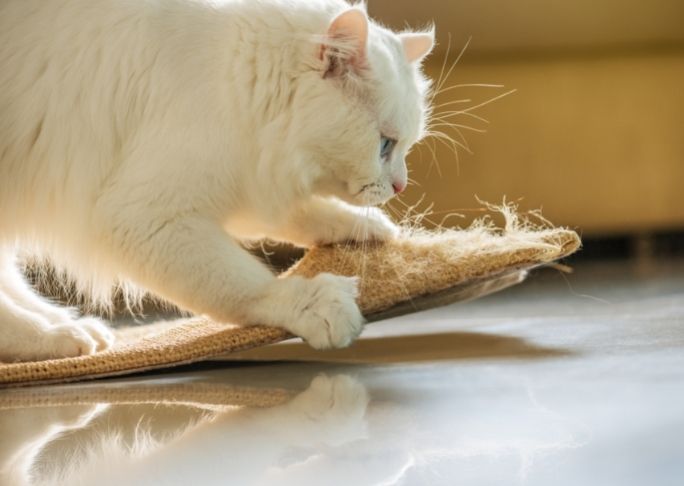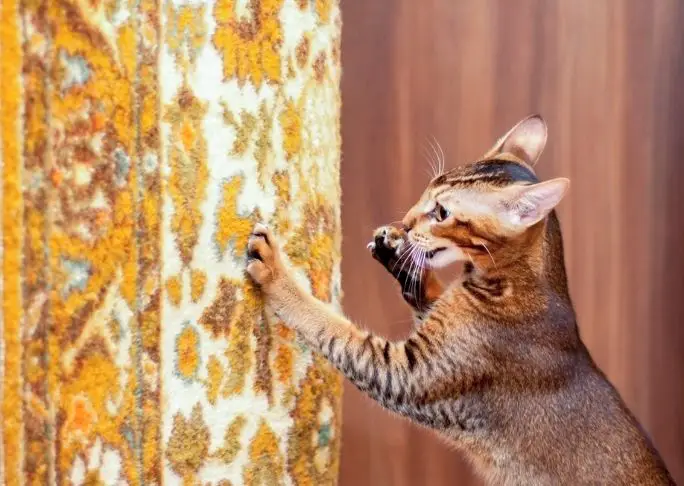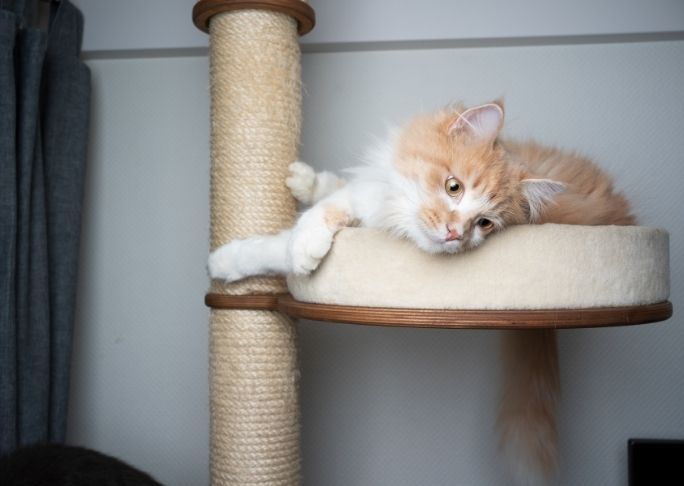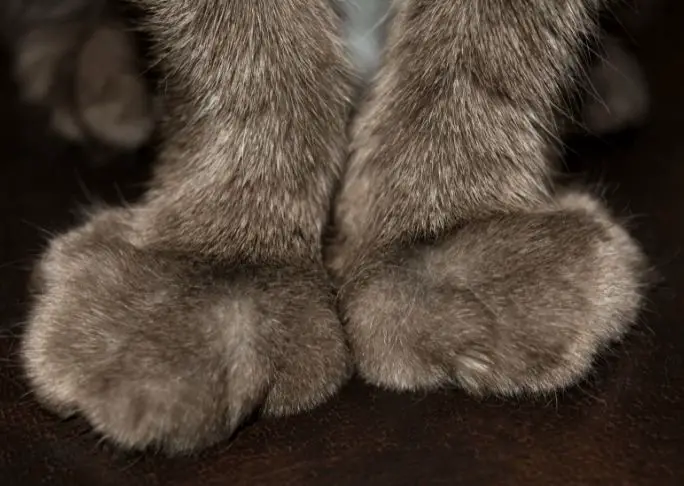Have you ever wondered how to train a cat not to scratch? Cat scratching can be damaging to the furniture, carpeting, and more items in the home. It can also cause infections in people if the cat chooses to scratch their owner hard enough to cause bleeding and the owner doesn’t treat it on time. That’s why I will be showing you how to train a cat to stop scratching.

Table of Contents
How To Train A Cat Not To Scratch
This training will help you reduce scratching and teach your cat your preferred location for scratching activity. It will help keep you and your furniture safe. Let’s start by understanding why cats scratch in the first place.
Why Do Cats Like To Scratch?
Cats have many reasons for scratching. Firstly they just like doing it! It can be a fun activity.
This post contains affiliate links. However all the information provided on this site are my own honest opinions. See more in Disclaimer.
They can also do it to mark their territory. Cats are territorial and can use it as a threat or warning signal to any other cat that wishes to enter their zone.
They also scratch as part of their grooming session. The process of scratching removes worn and dead nails to allow the new and sharper cat nails to become visible.
Finally, they can also do this during play sessions with their human or even while relaxing and stretching.
What To Do To Stop A Cat From Scratching
Cats will do what they want unless trained otherwise. Also, scratching comes naturally to cats, so the best way to handle the problem is to provide a place that your cat can be free to scratch without repercussion and provide the right motivation and reward to use it. Follow the tips below with multiple solutions and tips on how to train a cat not to scratch.
Also See:
1. Repel Cats From Scratching
Your pet is already scratching. Therefore, you will need an urgent solution to stop your cat scratching, as training may take some time. It would be best if you devised a means of repelling your cat from the places you don’t want your pet to damage while you learn how to train a cat to stop scratching.

Watch your cat, and immediately your feline friend tries to scratch any surface, make a move to stop the act. You can repel your cat by clapping your hands to catch your pet’s attention or by spraying your cat water.
Once your pet moves away from the surface, gently carry her somewhere else. If you aren’t there all the time, you can purchase a motion-based cat deterrent that will keep your cat away from furniture and areas you don’t want your cat to scratch.
It would be best if you didn’t scold, shout, or physically hit your cat to repel from the location as cats do not learn that way. It would be a waste of your time to do that and may cause your cat to become afraid of you.
2. Cover Common Scratching Surfaces
As mentioned earlier, cats love scratching, primarily on items that they can dig in their claws. So, it will be best to prevent your pet from doing that by covering all surfaces your cat may be interested in scratching on.
For example, if it’s a piece of furniture, you can use aluminum foils, sandpaper, or double-sided tape to cover the sides. These surfaces won’t be comfortable for your pet to scratch, and with time your cat will stop approaching the furniture.
As an alternative, you can also use sofa covers and anti-scratch stickers and stick them at the edges of important places such as your furniture so that if she scratches while you are away, it won’t destroy the item.
Also, you can smear the areas with odors your pet hates. For example, Cats hate citrus smell; orange, peppermint, lavender, lemongrass, etc.
3. Trim Your Cat’s Nails Or Cover Them
Trimming your pet’s nails means his scratching won’t be very damaging, which could discourage the act of scratching. Some cats scratch surfaces to self-trim their nails. So, you’ll be helping your cat groom, and your furry friend will be less inclined to scratch.
Trimming cat nails should be done with care, else you may injure your pet. You should carefully cut because cat claws are retractable. Try cutting your kitten or cat’s nails using nail clippers, nail grinders, or small pet scissors.
If you don’t know how to trim your cat’s nails, watch the video below or take your pet to a vet or professional groomer to help with it. Cutting after every ten days is recommended. See our post on how to groom a cat for more cat grooming needs.
You can also use plastic cat nail caps meant to be used on cat’s nails. They easily attach to the nails and will prevent your cat from doing damage when they are on. These are a temporary solution, and usually, the caps do not last more than six weeks, but that may be enough time to complete training your cat on where to scratch.
4. Give Your Cat Other Options
If you are looking for a sure way on how to train a cat from scratching furniture, giving your cat other options is the best. It’s simple, you don’t want your cat to scratch one thing, so you have to provide another. The item you should get is a scratching post.
How To Use A Cat Scratching Post To Stop A Cat From Scratching
Cat scratching posts are made for the sole purpose of pets like cats to scratch on them. They are usually textured like furniture, so your pet won’t tell the difference.

Place the scratching post in a prominent and strategic position. Somewhere that it catches your pets’ attention the minute your pet wants to scratch.
In most cases, you’ll need multiple scratching posts of different sizes and textures and place them in various locations near the items he likes to scratch on and also close to where your cat likes to nap.
Next, use some catnip to scent the area where the posts are placed. You can also choose to hide treats inside the scratching posts so your cat can find them when scratching. You can also hang cat toys on the post so your kitten can play with them.
Trending in Cats:
If your cat is yet to use the scratching post by now, you can try introducing your cat to it. You can do this by playing with your cat around the post using an interactive toy of some sort like a laser light. One thing you should never do is forcefully take a cat to the scratching post and try to force your cat to use it. Trying to force your cat may make your pet scared of the scratching post and avoid it. It can even cause your feline friend to become afraid of you and start hiding away from you.
Also, anytime you see your cat using the post, give a treat. Giving rewards like this will encourage your pet to scratch in the right place next time. You can also offer your cat praise by talking affectionately in a sweet voice, rubbing your cat’s ears, and other places that your cat likes when your cat is using the post. It will encourage your kitty to use it more.
With time your cat will show a preference for one type of scratching post. Now you can go and buy more of that and place it around the house.
Here are my top three recommended cat scratching posts that are high quality and come in various sizes to fit various sizes of cats. These will be very useful on how to train a cat not to scratch. Any of these should meet your needs. Also, they will allow your cat to stretch out in full to scratch, which cats prefer.
- Smartcat Pioneer Pet Ultimate Scratching Post
- PetnPurr Cactus Cat Scratcher
- Carpeted Base Play Area and Perch, Furniture Scratching Deterrent Tree
Finally, don’t dispose of old worn-out scratching posts. Cat’s like them shredded since they can dig in their claws and will keep using them. The used posts also smell familiar and welcoming to the cats.
5. Reward Your Cat For Not Scratching In The Wrong Places
You can hardly train your cat on anything without positive reinforcement. Rewards are always an advantage.
When you repel your pet from scratching, and your cat obeys and turns away, please give her a treat as a reward. Once she associates the reward with the act, she’ll learn not to scratch if she wants to get more goodies.
Also, if your cat goes to the scratching post to scratch instead of other surfaces like furniture, reward your cat with treats to keep it up. Cat treats can also serve as a distraction because if your cat is focused on wanting treats from you, he won’t have the time to scratch your high-value items.
How To Train Cats Not To Scratch You
The first thing your cat needs to learn is that your body is not a toy to play roughly with. Sometimes it’s the way we play with cats when they are kittens that lead to problems later. Start discouraging the scratching behavior as early as possible.

When your cat scratches you, tell your cat to stop by saying no in a firm but not a loud tone to discourage the behavior immediately.
Next, stop playing with your cat immediately and get up, and walk away from your cat. Ensure you do not go back to the cat for at least 15 minutes. That way, the cat will learn the behavior is unacceptable to you.
Also, ensure you play with your cat daily. See our post on how to make a cat feel happy for more ideas. Cats do very well with routine, and short daily play sessions may be enough to quell the scratching behavior.
Provide a calm environment for your cat and avoid stressing out your cat. A location change, your behavior, the environment can cause cats to become stressed and act out. Be sure to remove any triggers from the environment where your cat likes to stay.
Also, see our post on how to stop a cat from biting and attacking me and how to calm an aggressive cat if your cat is displaying more serious problems.
In addition, if you have tried all the suggestions here without any improvement, be sure to see a vet rule out any medical causes. Finally, see the video below with a visual demonstration of some of the steps here.
Should You Declaw Your Pet?
A lot of cat owners consider declawing as an ideal means of stopping their pets from scratching. Declawing is a surgery whereby your cat’s nails are removed, and no, it’s not something you should do to your pet.

According to various experts, declawing your cat is equivalent to cutting off the last finger. The surgeons don’t just remove the nail; they have to remove a bone as well. The process is quite harmful, causes a lot of pain, needs a lot of surgery recovery time, and could adversely affect your pet.
You should only declaw your pet if it’s required for a severe medical purpose, not because he’s scratching.
Final Tips On Cat Scratching
Your pet isn’t scratching you or your furniture or other home decors to destroy it or get back at you for something. It’s normal for your cat to stretch his muscles, play with fun items, mark his territory, or attend to his claws.
If you want your cat to stop, declawing shouldn’t be part of your options. Follow the tips on how to train a cat not to scratch listed above. Also, see our post on how to train a cat to be well-behaved.
Loved this post on how to train a cat to stop scratching? Then share it with others.








